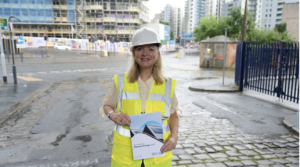How to… build collaborative places
 The need for greater collaboration at a local level is a no-brainer, but making it happen is not easy. Annabel Davidson Knight pinpoints three shifts needed for effective co-production.
The need for greater collaboration at a local level is a no-brainer, but making it happen is not easy. Annabel Davidson Knight pinpoints three shifts needed for effective co-production.
The idea that people, communities and the voluntary sector are key to building vibrant, collaborative places will not be news to anyone. We know that efforts by those with the power and money to achieve systemic social change fail unless you make real efforts to co-produce solutions. We know that joined-up, preventative interventions to social challenges result in far better outcomes for everyone, not just those accessing the support.
We also know that public services are struggling to solve some of our most pressing social and economic challenges and that there is huge variation in the outcomes of different towns, cities, and neighbourhoods. In other words; there is a mismatch between what we know works and how successfully those approaches are implemented.
The voluntary, community and social enterprise sectors (VCSE) have a vital role to play in enabling citizens to shape the places in which they live. Yet research shows there is a disconnect between those sectors and those in charge of local public services in many areas. In some places the traditional, paternalistic relationship between the two prevails with the result that smaller voluntary and community organisations are being routinely squeezed out of contracts, as research by the Lloyds Bank Foundation shows.
In our recent report, Building Collaborative Places, we identified some of the key ‘building blocks’ to creating real, systemic change in a place. Each of these ‘blocks’ provides a starting point for shifting to a more collaborative way of working across sectoral and issue silos, with instances of how specific places have shifted practice to improve outcomes for citizens. It argues for social organisations and the public sector alike to put outcomes for people ahead of organisational priorities and for genuine recognition of the behavioural and cultural shifts required to work in a truly collaborative, systemic way.
‘In some places the traditional, paternalistic relationship
between the public sector and community organisations prevails’
There are particular opportunities emerging now to create a step change: a whole range of macro issues are forcing local public services to think differently and seek new ways of working; rapid service transformation is taking place, particularly in devolved regions; and more and more independent funders are talking about place-based approaches to support local communities. If the voluntary sector and community groups are going to make the most of these opportunities certain shifts are required;
- Voluntary sector representative bodies: from lobbying to brokering: Few are able to hold the space between public sector and citizens and community groups, and act as a system translator. As localities look to new ways to create thriving communities with less, such brokerage is desperately needed. Like the ‘single point of contact’ role for local VCSE representative organisations suggested by both the VCSE Review and the Realising the Value reports published last year. Facilitating collaboration within voluntary and community organisations is important too – many small organisations find this hard to do for a variety of reasons and need support. Action Together Oldham is one such organisation doing this well.
- National and umbrella bodies: from national to local influencing: As national context and policies continue to drive whole-place collaboration, umbrella bodies must look at the opportunities of working with local decision makers. The Campaign to End Loneliness took this approach and has successfully supported a large number of Health and Wellbeing Boards to provide strategic responses to loneliness in their areas – arguably achieving far greater impact than national campaigning would have done.
- Small and medium organisations: understanding the value of collaboration. For many, collaboration is viewed as synonymous with mergers and restructures, leaving many circumspect. Collaborate’s work in places has found that those organisations that are able to take the time to understand the power of a collective ambition, and appreciate the distinctiveness and value of each other’s roles achieve real impact and reduce duplication by working together. Whether that is by working across silos on complex issues, like the Making Every Adult Matter approach (pictured above) – or in aligning or even merging with others in your space, methods of collaboration need not squeeze out the specialist provision the sector does so well.
These shifts are not simple. And as Collaborate’s latest report argues, they require a number of pre-conditions to be acknowledged. These include the recasting of public services, seeing them as part of a local system which includes families, local voluntary organisations, businesses, universities and others; a harnessing of the collective power of the system; and an understanding the role that different actors can play in improving local outcomes.
- To find out more, please contact Annabel@collabroateCIC.com.















